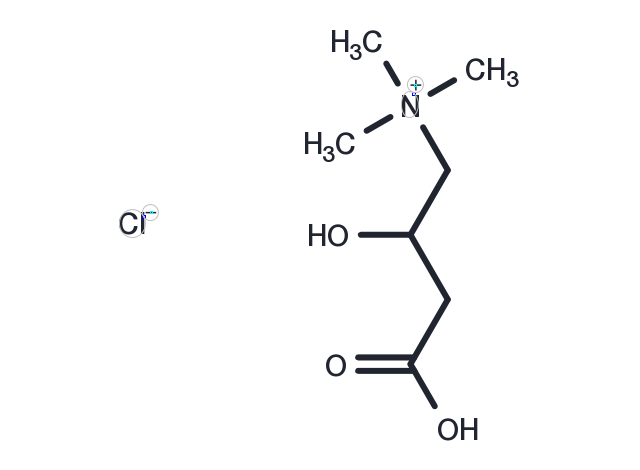Powder: -20°C for 3 years | In solvent: -80°C for 1 year


(±)-Carnitine chloride (Monocamin) is a quaternary ammonium compound biosynthesized from the amino acids lysine and methionine.

| Pack Size | Availability | Price/USD | Quantity |
|---|---|---|---|
| 500 mg | In stock | $ 41.00 | |
| 1 mL * 10 mM (in DMSO) | In stock | $ 45.00 |


| Description | (±)-Carnitine chloride (Monocamin) is a quaternary ammonium compound biosynthesized from the amino acids lysine and methionine. |
| In vitro | L-carnitine primarily facilitates the translocation of long-chain fatty acids across the inner mitochondrial membrane by transforming acyl-CoA into acyl-carnitine via carnitine palmitoyl transferase (CPT)-I activation. This acyl-carnitine is then converted back into acyl-CoA within the mitochondrial matrix by CPT-II. L-carnitine's introduction enhances palmitoyl-CoA-induced mitochondrial respiration, further accelerated by ADP, showcasing a concentration-dependent effect that reaches saturation at 5 mM L-carnitine[1]. Additionally, L-carnitine pre-treatment enhances Nrf2 nuclear translocation, its DNA binding activity, and heme oxygenase-1 (HO-1) expression in Water2-treated HL7702 cells, providing protection against Water2-induced cell damage through Akt-mediated Nrf2 signaling pathway activation[2]. |
| In vivo | L-carnitine has been shown to modulate the ubiquitin-proteasome pathway and enhance IGF-1 levels in animal studies. Its administration over two weeks can mitigate muscle mass and fiber size reduction in the soleus muscle caused by hindlimb suspension. Additionally, L-carnitine inhibits atrogin-1 mRNA expression, crucial for preventing muscle atrophy. Concurrent L-carnitine treatment also reduces renal fibrosis—associated with lowered plasma TGF-β1 levels—and addresses the enhanced oxidative and inflammatory states observed in L-NAME treated groups, alongside promoting PPAR-γ expression. |
| Kinase Assay | Mitochondria (0.6 mg protein/mL) are incubated in 2.5 mM Hepes (pH7.4) containing 225 mM mannitol, 75 mM sucrose and 100 μM ethylene glycol tetraacetic acid (EGTA) with or without 5 mM L-carnitine at 25°C. To measure oxygen uptake, 10 min after inorganic phosphate (Pi) 4 mM are added, the mitochondria are treated with palmitoyl-CoA (50 μM) and then ADP is added (200 μM). Oligomycin (5 μM) and rotenone (10 μM) are added 3-4 min after the ADP treatment. HPG (0-10 mM), which can specifically inhibit carnitine palmitoyl transferase (CPT)-I activity in the mitochondria, is added in the Hepes medium before incubation of the mitochondria[1]. |
| Synonyms | Monocamin, DL-Carnitine HCl, Bicarnesine, DL-Carnitine chloride |
| Molecular Weight | 197.66 |
| Formula | C7H15NO3·HCl |
| CAS No. | 461-05-2 |
Powder: -20°C for 3 years | In solvent: -80°C for 1 year
H2O: 37 mg/mL (187.2 mM)
Ethanol: < 1 mg/mL (insoluble or slightly soluble)
DMSO: 38 mg/mL (192.2 mM)
You can also refer to dose conversion for different animals. More
bottom
Please see Inhibitor Handling Instructions for more frequently ask questions. Topics include: how to prepare stock solutions, how to store products, and cautions on cell-based assays & animal experiments, etc.
(±)-Carnitine chloride 461-05-2 Immunology/Inflammation Metabolism NF-Κb Reactive Oxygen Species DL-Carnitine Chloride (±) Carnitine chloride inhibit Inhibitor Monocamin DL-Carnitine HCl Bicarnesine (±)Carnitine chloride DL-Carnitine DL-Carnitine chloride Carnitine Chloride (±)-Carnitine inhibitor
